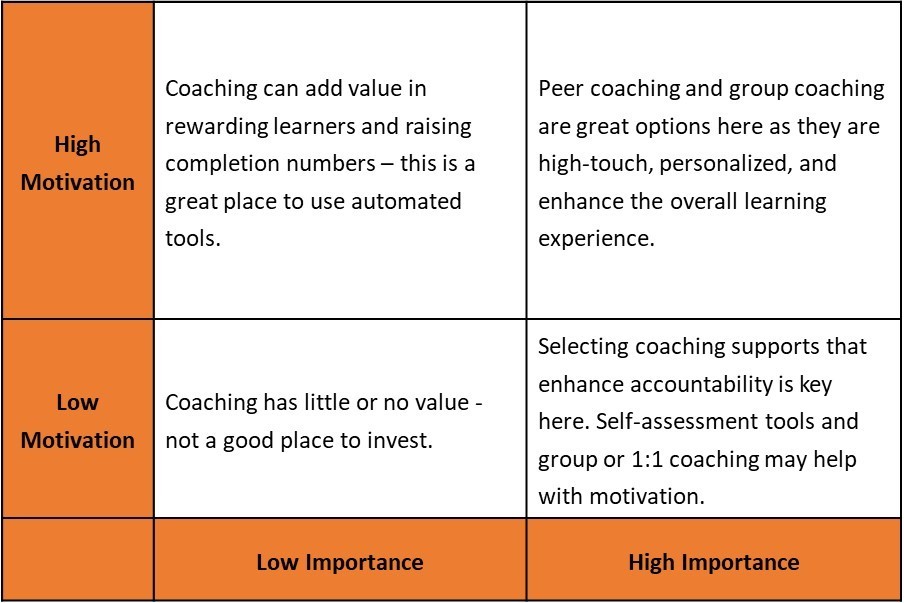Coaching For Corporate eLearning: The Why And How
Incorporating coaching into an eLearning program can yield a wide range of benefits for both employees and the organization. Coaches create value by promoting accountability, challenging learners, reframing questions or challenges, and championing individuals.
The Benefits Of Coaching In eLearning Programs
Examples of the benefits of adding coaching to an eLearning program include:
- Personalized learning experiences
Coaching enhances the effectiveness of learning solutions by offering opportunities for greater support including addressing their interests as well as challenges and goals. - Increased engagement
Learners feel more connected to the material when they have opportunities to ask questions and receive feedback. Having a coach present also builds greater accountability and focus. - Better understanding and application
Coaches can be an important bridge between concept and application in a business setting, customizing examples for individual learners and asking questions that challenge learners to think more deeply. - Supporting learners "in the flow of work"
Coaches can be on hand during or after a learning experience to support learners as they take on new challenges and try out new skills. - Motivation and confidence
Positive reinforcement and constructive feedback from coaches can boost learners’ motivation and confidence and can lead to a greater willingness to take on new challenges and explore innovative solutions.
Overall, coaching has been shown to increase self-confidence, improve relationship-building and communication skills, and improve overall work performance. Broader organizational benefits include enhancing virtual ways of working, creating a culture of learning and growth, and increasing employee engagement.
The Different Types Of Coaching Tools
Today there are many different types of coaching that can be integrated into a corporate eLearning program, ranging from high-tech and scalable to high-touch and personalized, which include:
- Automated agents
They connect with learners via text or chat. These agents can provide reminders, tips, and motivational messages. - AI-powered virtual assistants
These interact with learners through natural language interfaces, answering questions, providing suggestions, and offering guidance. - Self-assessment and reflection tools
Online or written tools that guide learners through a process that helps them identify areas for improvement and set goals. - Performance support tools
Mobile apps or digital tools that provide in-the-moment, content-based coaching on specific challenges. - Peer coaching
Learners are paired with colleagues (sometimes more senior, sometimes of the same level) to answer and discuss questions or challenges together. - Group coaching
A trained coach works with a group of 3-8 people on a specific topic or challenge that they share. This can be done in synchronous meetings or asynchronously via Slack or discussion forums. - One-on-one coaching
It is a more traditional model that provides the highest level of support and customization, where a trained coach works with a single learner. It is also the least scalable of all approaches.
Considerations When Selecting Coaching Tools Or Methods
When selecting a coaching method it is important to consider fit-for-purpose. For example, automated agents can help drive accountability to complete at scale and on time with an engaged group of learners, but they will fall on deaf ears if learners aren’t already convinced that the learning is relevant and important. Also, automated agents have a limited ability to enhance learning through questions—they might ask provocative coaching-type questions initially but are much less able to ask the types of personalized follow-up questions that a trained coach can ask that will truly deepen learning.
Here are some key questions to consider when adding a coaching component to an eLearning program.
1. How Easy Or Complex Is The Concept Or Topic?
For compliance training that is rolled out company-wide, having performance support tools available is a great choice—it is highly scalable, relatively low cost, and will enhance application. On the other hand, learners who are tackling a developmental skill, such as managing difficult conversations, or a highly technical skill, such as advanced C++, might benefit from online peer or group coaching.
2. How Important Is This Training? How Motivated Are Learners To Complete This Training?
It is helpful to consider these two questions together as there are different trade-offs depending on the answer to each. Here are some suggestions in a 4x4 grid.

Coaching components do increase the overall cost of the eLearning program. When building a case for ROI, think about the following: "Realistically, will this learning program achieve its goal in terms of engagement and desired change without coaching support?" If the answer is yes, then the investment isn’t needed. But if the answer is "maybe" or "no", then, building a case for the additional investment to fund coaching support makes sense.

